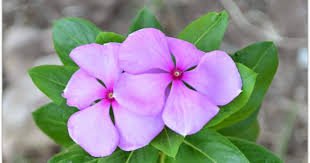Welcome to your holistic living

Botanical Name: Catharanthus roseus
Family: Apocynaceae
English Name: Periwinkle
Malayalam Name: Shavam Naari
Hindi Name: Sadabahar
Nithyakalyani (Sadapushpa, Catharanthus roseus) is a perennial herb belonging to the family Apocynaceae. Habitat: Native to Madagascar, but naturalized and cultivated widely across India, especially in gardens and temple premises. It thrives in warm climates with sandy to loamy soils and can withstand drought conditions. Morphology: An evergreen subshrub, growing up to 60–100 cm in height. Leaves are opposite, simple, oval, glossy green with a short petiole. Flowers are pink, white, or purple with five petals and appear throughout the year, giving the plant the name “Nithyakalyani” (ever-blooming). The fruits are cylindrical follicles containing small brownish seeds. Grahya Lakṣaṇa: The plant should be fresh, with vibrant green leaves and regularly blooming flowers. Roots should be firm and free from decay. Ideally selected plants are those that grow in uncontaminated soil, not near waste dumps or polluted water sources.
Leaves, root, flowers
Cancer treatment: Vinblastine and vincristine were the first plant-derived anticancer agents to be used in chemotherapy. Vinblastine treats Hodgkin's disease, lymphosarcoma, breast cancer, lung cancer, and testicular cancer. Vincristine is used for acute leukemia in children, Hodgkin's disease, and neuroblastoma. Diabetes management: The plant has been used traditionally for diabetes, and modern studies have shown its potential. Alkaloids like vindoline and vindolicine have been shown to increase glucose uptake and inhibit enzymes involved in insulin signaling. Neuroprotective effects: Extracts and compounds like serpentine have shown potential for treating neurodegenerative conditions like Alzheimer's disease by inhibiting acetylcholinesterase, an enzyme that breaks down a key neurotransmitter. Antihypertensive and cardiovascular effects: Some compounds, such as ajmalicine and reserpine, can help lower blood pressure by acting as a vasodilator and affecting neurotransmitter levels. Wound healing: Studies have demonstrated that extracts from the flowers and leaves can accelerate wound healing in rats, including diabetic rats. Antimicrobial effects: Extracts from the leaves, stems, flowers, and roots have shown antibacterial, antifungal, and antiviral properties. Antioxidant activity: The plant contains phenolic compounds and flavonoids with antioxidant properties that can help neutralize free radicals and reduce oxidative stress.
Antidiabetic,Anticancer,Antihypertensive,Wound healing,Antimicrobial
Rasa: Tikta, Kashaya
Guna: Laghu, Ruksha
Virya: Sita
Vipaka: Katu
Dosha Karma: Kaphapitta shamaka